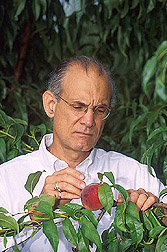|

Horticulturist Ralph
Scorza. Click the image for more information about it.
|
|

|
Crimson Rocket Peach Making Its Way to
Market
By Sharon
Durham November 15, 2007
Crimson Rocket peach trees look like tall, thin cousins of the more
classically-shaped peach trees. These "skinny" trees provide an attractive,
space-saving tree that produces full-size peaches that could make their way to
consumers in 2008.
Agricultural Research Service (ARS) horticulturist
Ralph
Scorza and his colleagues in the
Appalachian
Fruit Research Station at Kearneysville, W.Va., developed the "columnar"
variety. The tree was patented and released in 2001 for experimental evaluation
in orchards across the United States.
Crimson Rocket has been licensed by several commercial nurseries in
Missouri, Pennsylvania and California. The trees have been in commercial
orchards for the last three years and Crimson Rocket fruit may begin to appear
in local marketplaces next spring.
A fully grown Crimson Rocket tree has a diameter of about five feet
and fits neatly into a small yard. In commercial settings, the compact trees
can be planted much closer together than conventional trees that spread out to
a width of 16 feet. Crimson Rocket's columnar shape translates into more
peaches per acre, while land and production costs are similar.
According to Scorza, Crimson Rocket was bred for high-density
production systems, allowing for a new concept in peach production. Its shape
also makes it a novel and useful fruit tree for home gardens.
Crimson Rocket has two copies of a naturally occurring gene that sends
the branches skyward. It produces yellow-fleshed, dessert-type peaches that are
firm, sweet and aromatic. The medium-sized fruit stores well and softens when
completely ripe.
ARS is the U.S. Department of
Agriculture's chief scientific research agency.